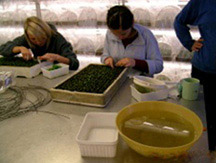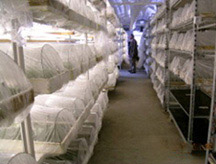









Propagation of Blueberry
New article:
Improving Tissue Culture Plantlet Transplanting in the Fourth and Fifth (Greenhouse) Stage Production
Propagation of Blueberry by Cuttings
Propagation of Blueberry by Tissue Culture
Two thesis on Blueberry Propagation (download)
Improving Blueberry Propagation in the Tissue Culture Green House Stage (download)
Propagation of Blueberry by Cuttings
Highbush Blueberries are not easy to propagate by cuttings, but, good results can be
obtained.
There are many ways to do it. It will take trials to determine which methods
and rate will work best for you.
Always use the best quality cuttings. Junk cuttings yield
junk plants!
Treat the cuttings using Hortus IBA Water Soluble Salts by solution methods or Rhizopon AA #3 by the dry dip method.
How to root blueberry cuttings:
Blueberry cutting selection:
Cuttings taken in the Dormant season:
Take cuttings while plants are dormant; vigorous, firm, pencil-size, unbranched
shoots of the last season’s growth.
Cuttings taken in the Growing season (preferred)- see Softwood Cuttings (below):
Take cuttings about 6-8 weeks after new growth starts: an indication may be when stems darken color from bright green.
Only use vegetative wood without fruit buds.
Blueberry softwood cuttings:
Blueberries root more easily by softwood cuttings.
Softwood cuttings
> require a mist system
and well ventilated propagating structures.
> are susceptible to leaf
diseases.
> because of control and disease, softwood cuttings require more
control then hardwood cuttings.
> shoots of the first seasonal flush of growth make the best wood for cuttings.
> take cuttings before fruit buds start to form.
Taking blueberry cutting:
Cuttings should be 5 to 9 inches long, with 2 or 3 leaves.
Place cuttings 2 inches deep into rooting media made up of equal parts of perlite
and peat moss.
Wound the cuttings before hormone treatment.
Blueberry rooting hormone treatment:
Use the higher rates for Dormant cuttings.
Use the lower rates for Softwood cuttings.
> Method 1 (Basal Long Soak):
Hortus IBA Water Soluble Salts @100-200 ppm IBA by the Basal
Long Soak Method.
Soak 1" of the basal end of the cuttings for 12-24 hours,
then stick or put in cold storage.
> Method 2 (Spray Drip Down®):
Hortus IBA Water Soluble Salts @1000-1500 ppm IBA by the Spray Drip Down®.
Stick the cuttings, then, spray the leaves of the cutting
with the solution until the liquid drips down.
> Method 3 (Dry Dip Method):
Rhizopon AA #3 dry powder rooting hormone by the Dry Dip Method.
Dip the basal end of the cutting 3/4-1" into the powder then stick.
Sticking blueberries:
Space cutting 2” apart with the top bud just visible.
Media for blueberries:
Use a well draining soilless media such:
> half peat to half sand or
> half peat to half pearlite
Control:
Use a poly house or use a tunnel to cover the cuttings and control humidity.
Bottom heat for blueberries:
Use bottom heat at 68-73F
Media moisture for blueberries:
Keep media moist until leaves appear.
Humidity (Air moisture) for blueberries:
Use misters to keep humidity high.
When leaves appear the poly should be raised slightly for ventilation.
Possibility for blueberry root formation under ideal conditions (using juvenile cuttings):
Softwood cuttings: may root in 2-7 weeks with relatively high success rate.
Hardwood cuttings: root in up to about 8 weeks. Unpredictable success can range about half to almost full rooting percentage.
The Basal Long Soak Method may improve rooting success.
Relative ability to root blueberries by selected variety:
Easy to root: Bluetta, Patriot, Northland, Blueray, Berkeley, Coville, Jersey
Moderate to root: Earliblue, Collins, Olympia, Herbert, Jersey, Elliott, (1613-A)
Harder to root: Spartan, Bluejay, Ivanhoe, Bluecrop, Darrow
To top of page
Propagation of Blueberry by Tissue Culture
Blueberry Tissue Culture (TC) plantlets are often bushier than those propagated from conventional cuttings.
Propagated from these TC plantlet cuttings, the next stage plantlets pass on the same improved bush level, giving high fruit yields.
Tissue culture stages:
Stage I:
Under sterile conditions in the laboratory, the growing point of the plant, such as a shoot tip or bud, is excised from the stock plant and placed into a simple growth medium where it develops into a tiny plantlets.
Stage II:
The stage I plantlets is transferred into a different growth medium containing plant hormones that will encourage the plantlets to produce more plantlets.
In this stage, the number of plantlets is increased through a series of transfers to fresh medium.
This process continues until the desired number of plantlets is produced.
Stage III:
The stage II plantlets are transferred to another different medium that will prepare them for transfer to a greenhouse environment.
Stage IV:
The stage III plantlets are removed from stage III medium and planted in a greenhouse where they root and acclimate to the greenhouse environment.
Greenhouse Production: Stage IV plantlets are rooted, acclimated, and grown on to a field–ready plug plant.
This process takes 8 – 12 weeks.
These plug plants are the foundation stock for nurseries.
The greenhouse production area looks like a TC growth room (typical).
Domes are used because the cuttings are very soft and require good environmental control.
The cuttings used are usually from the top of the stock plants. Lower cuttings with no top, but three leaves are also used.
The Stage IV plantlets are totally immersed in an aqueous solution containing
Hortus IBA Water Soluble Salts rooting solutionb at 50-150 ppm IBA.
A plastic small screen basket is used to dip the plantlets so as no to cause damage to the tender plant tissue.
The plantlets are dipped about five seconds.

The plantlets are stuck in a tray. 325 trays are suitable.
The trays are then covered with a transparent dome
Plantlets are kept under artificial light such are those used in TC lab lights.

After about 2-3 weeks the plantlets are moved to a greenhouse to harden off by controlled lowering of humidity.
The greenhouse allows the plantlets to utilize the broad spectrum of natural sunlight.
To top of page